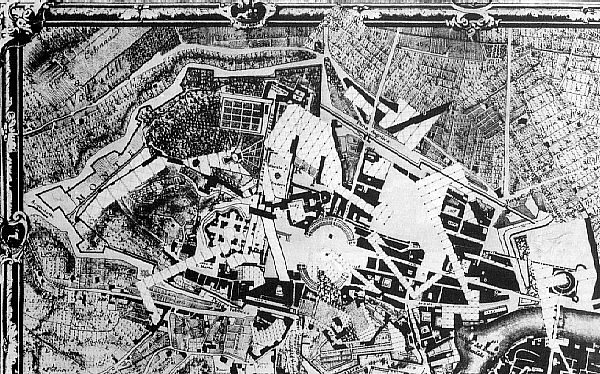2007.11.03 09:19
Collage Architecture
Collage was also implemented throughout Roma Interrotta.

Piero Sartogo, Roma Interrotta: Sector I, 1978.
2008.08.07 08:44
I smell a Vorläufer
"The errors that Robert Adam detected in Palladio's drawings for the reconstruction of the 'Baths', published in 1730 as Fabbriche antiche disegate da Andrea Palladio, encouraged a dismissive attitude to Palladio and led him to question the accuracy of the renaissance as a reliable recorder of classical architecture. It became easy for the brothers to delude themselves into thinking that they alone possessed a deep insight into the antique and had the knowledge necessary to correct the errors of renaissance draughtsmen. But such an arrogant stance was more a public one, which did not stand in the way of their serious study of the renaissance or their need to borrow directly from it, from time to time. The enormous variety found there appealed to them as much as the inventive classicism of the antique."
--Tait
Just as an aside, Fabbriche antiche disegate da Andrea Palladio was used in the formation of Roma Interrotta Sector VI.
| |
2009.01.14
'megalomaniac frustrated architect'
from James Stirling, "Revisions to the Nolli Plan of Rome (The MFA Solution) and notes towards the demise of the post war planning profession" (1977):
Megalomania is the privilege of a chosen few. Piranesi who made his plan in 1762 was surely a megalomaniac frustrated architect (MFA), as also Boullée, Vanbrugh, Soane, Sant'Elia, Le Corbusier, etc., and it is in this distinguished company as an MFA architect that we make our proposal.1 The megalomaniac architect is most frustrated with regard to projects designed but not built, so the initial decision was to revise Nolli's plan incorporating all our unbuilt works. Soon we were trying to incorporate the entire oeuvre. ...
... Expediency and commercialism corrupt the possibility of quality in urban design and irrational procedures and reverse priorities seem the 'stock in trade' of the planning profession. Thus cities have lost their identity and towns people are numbed with problems of memory and their children grew up in kitschplace and junkland.
1. 'Architects used to need kings and dictators to liberate their megalomania, but now they do a better job themselves. They think that they are given large sums of money to play games with, just as a child or a Rembrandt for that matter is given a cheap box of paints. So Gropius flees Hitler and inflicts the Pan Am building on New York. Stirling inflicts the glasshouse on Cambridge. Frank Lloyd Wright's houses are notorious hell to live in. Even Saarinen foists his protégé's unbuildable Opera House on Sydney. The common factor is a complete disdain for the people who have to live with it. (God help me, I'm going to have to live with the glasshouse!) All this is in the authentic tradition of Vanbrugh and Gilbert Scott. Nothing matters to these men but their reputation in the art-histories. They are not so much undemocratic as antidemocratic: structural fascists. The astonishing thing is that Hitler was a failed painter. Stalin a failed divine. Had they been failed architects, they would have shed blood, not in rivers, but in oceans.' Hugh Brogan, The Cambridge Review, October 1968. (Such is the hysteria of some Oxbridge Dons when confronted with modern architecture. This was an early effort in the now-fashionable tirade against architects in the UK).
Guy Châtel, "Facts and Figures" in OASE #79 James Stirling, 2009.
| |
Amid this gamut of responses, that of Stirling stood out for its refusal to enter into any kind of utopian urbanism and in the distance it took from the other entries. And, despite Stirling's own reference to Rowe's "Collage City" model, his approach was anything but collagist, and owed as little to Rowe as it did to Krier[?]. Indeed, if an analogue might be found it would still be that of Rossi, with his belief in articulated typologies.
Anthony Vidler, James Frazer Stirling: Notes from the Archive (New Haven: 2010), p. 213.
Stirling's [Roma Interrotta] text then reads like a stroll through the Gianicolo, an architectural promenade through the ideal city of his projects, almost like a mapped version of John Soans's oeuvre painted as an ensamble by Gandy.
Anthony Vidler, James Frazer Stirling: Notes from the Archive (New Haven: 2010), p. 215.
2010.12.08
Stirling's Roma Interrotta and Le Corbusier's Berlin 1958
The clear precedent for Stirling's Roma Interrotta scheme is Le Corbusier's International Planning Competition for Berlin 1958. In the Le Corbusier scheme we find several prior projects distributed throughout the plan.
2011.01.04 21:18
Bilocation Syndrome
It's very strange for Meier to say he was involved with Roma Interrotta when in fact he was not one of the 12 architects involved with Roma Interrotta.
Plus, the Whites vs. Grays 'debate' was a mid-seventies thing. There is even an A+U magazine from 1975 or 1976 with the whole theme of Whites vs. Grays. Not to mention Tafuri's "American Graffiti: Five x Five = Twenty-five" in Oppositions 5 (Summer 1976) -- "Tafuri maintains that, notwithstanding the hermetic polemics of "Grey" versus "White"..."
Amanda Reeser Lawrence, "The Return of the Dead: Stirling's Self-Revision at Roma Interrotta" in Log 22, 2011.
Maarten Delbeke, "Roma Interrotta: Baroque Rome as (Post)Modernist Model" in OASE #86 Barok/Baroque, 2011.
|
